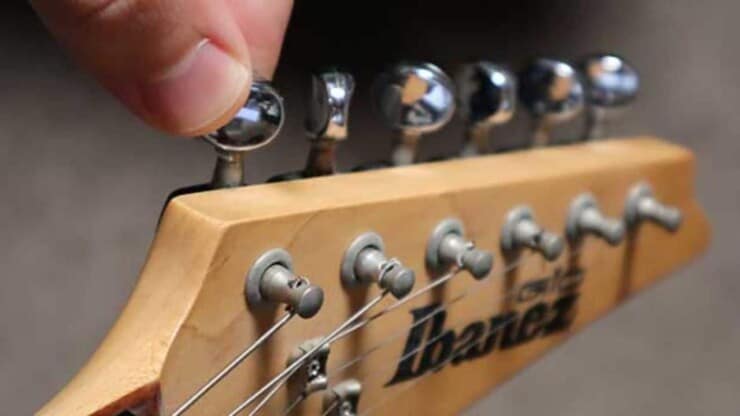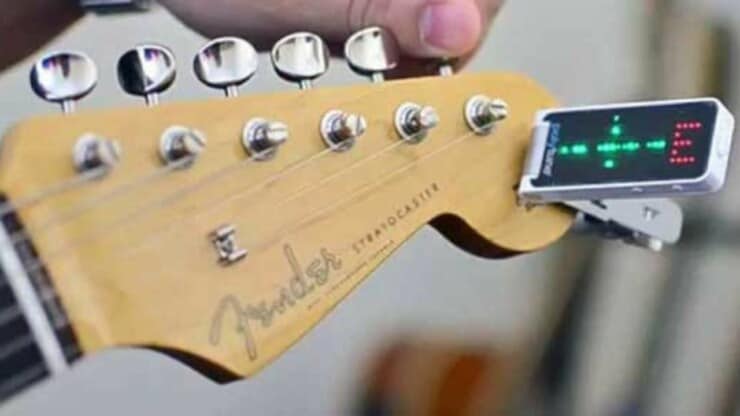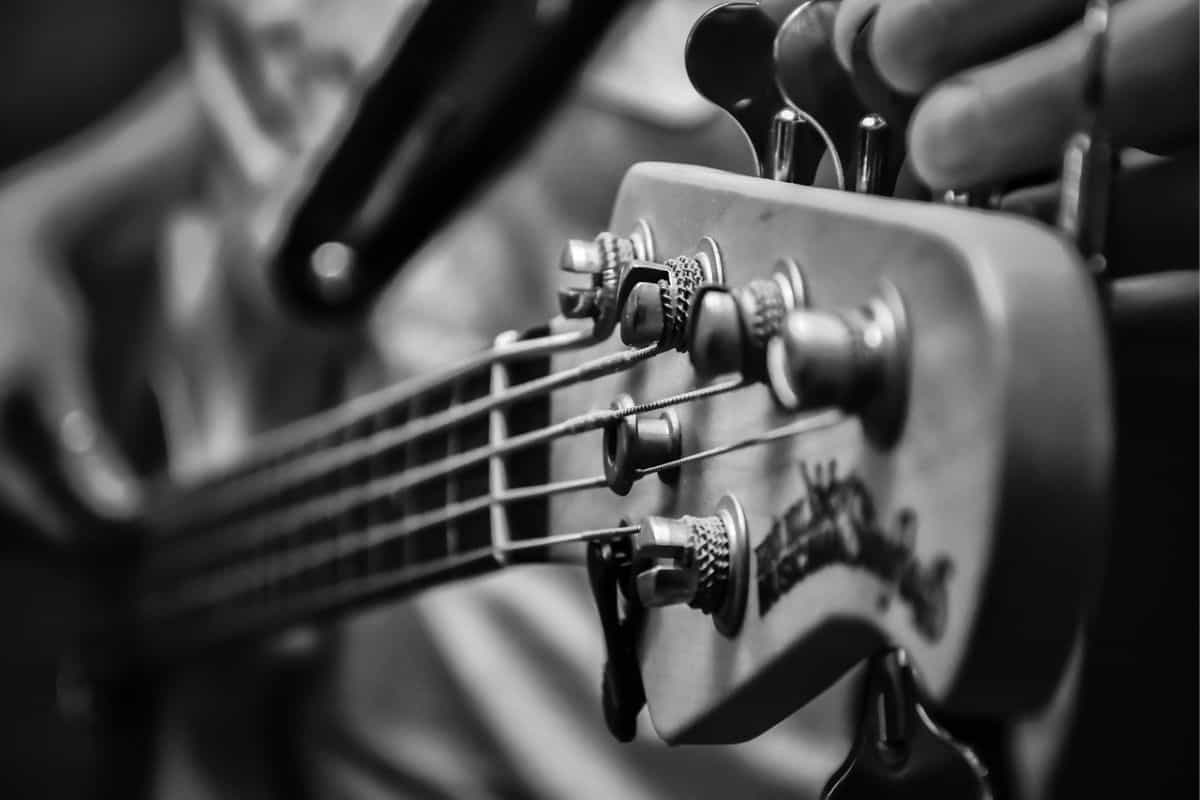Do you ever find yourself wanting to tune the guitar without the amp, but you don’t know how to? If so, then this article is just what you need.
Tuning electric guitar without amp is extremely simple and there are multiple ways to do that. You can do it with a tuner pedal, with a clip-on tuner, using your ears, and more.
In this article, you’ll get to know all about tuning an electric guitar, the basics of tuning a guitar, different types of tuners, how to tune electric guitar without amp, different ways of tuning an electric guitar, and more. Stick around to know the answers to all of your doubts.
Basics of how to tune electric guitar amp with amp
While there are multiple ways of tuning an electronic guitar, all of them ultimately lead to the same goal. The idea behind tuning a guitar is to tune each string to a specific pitch when playing chords or riffs. Before reading through different tuning methods, it’ll be a great idea to understand the basics of tuning a guitar.
Standard tuning
The most common tuning that you’ll use on electric or acoustic guitars is called Standard Tuning. Standard tuning will tune the six strings on the guitar (from the thickest to the thinnest) to the pitches- F, A, D, G, B, E. Both the electronic and acoustic guitars can be tuned to standard tuning regardless of the guitar’s tuning heads being on the same side or split over different sides of the headstock. The thickest string on the guitar will be the lowest sounding, and you should tube that to E.
After that, the next string will be tuned to A, then D, G, B, and lastly E on the thinnest string. If you’re a beginner, most of the music you’ll be playing is likely using Standard Tuning. Practice tuning the guitar to standard tuning with the methods mentioned in this article.
Alternate tunings
There are many other different tunings for guitar, and they’re known as “Alternate Tunings”. The most common alternate tuning is known to be “Drop D”. Here, you’ll be changing the low E string to D (and drop the E string). If you’re looking to learn a track that uses a tuning other than standard tuning, the transcription of the guitar tab will tell you what the tuning is. For instance, if the song you’re looking to learn says that it is in “Drop D” tuning, you’ll have to change the guitar’s tuning to Drop D Tuning. Otherwise, it won’t sound quite right.
Tuning the guitar in an alternate tuning isn’t harder than tuning the guitar to standard tuning. You need to know what to tune each string to and take time tuning each string. Some alternate tunings might need you to change to thicker or thinner guitar strings. This normally happens when you have to tune the strings really low. A lower tuning will slacken the strings, which means you’ll need to use thicker strings for better tension.
The basic method to tune an electric guitar
Regardless of the type of tuner you’re using, you’ll need to follow the same basic method to tune your guitar. Here is the basic method of how to tune electric guitar without amp.
Step 1: Check the tuning of the string
Start off by picking the thickest string that is closest to you when you’re holding the guitar. The thickest string on a 6-string guitar will be tuned to E in Standard Tuning. Check the tuner to see whether the string is too high, too low, or in tune. It’ll be perfectly in tune, you’ll then be able to move to check the next string. In case it isn’t perfectly in tune, head over to the next step to adjust the tuning.
If you’re seeing different note names on your tuner, it’ll mean that the string is way out of tune. You should take note of whether you’ll have to raise or lower the string and bring it to E. For instance, if you’re seeing “D” or “Eb” on the tuner, D or “Eb” will both be lower than E. You’ll have to raise the string’s pitch and bring it to E.
Step 2: Adjust the string’s tuning
Once you know that you have to adjust the strings up or down, start adjusting the string’s tuning.
Start off by picking the string. It is important that you should listen to the strings as you’re adjusting the tuning.
Slowly turn the string’s tuning head while listening to how the pitch changes. You need to hear the pitch rise or fall. If you’re not hearing any change in pitch, ensure that you’re tuning the correct tuning head. You might snap a string if you’re not aware that you’re tuning the wrong tuning head. The direction you’ll have to turn the tuning head will depend on the type of guitar and headstock. This is why you must learn to listen to the string when you’re adjusting to the tuning. This will help you ensure that you’re turning it the right way. Watch your tuner when you’re adjusting the strong for ensuring that you’re tuning it in the right direction.
Re-pick the string when you start tuning if you have trouble detecting notes or hear the notes start fading away. Keep picking the string once every few seconds to keep the strings loud enough for the tuner. Use small adjustments as you’re getting closer to the perfect tune. More significant adjustments normally end up with overshooting and needing to adjust the tuning in the other direction over and over.
If you have to lower the string’s pitch, it’ll be a great idea to bring it under the tune slightly and tune it up to pitch. It can help avoid the string slipping when you’re playing the guitar and bringing it out of tune.
Step 3: Tune the strings
Once the low E string is in tune, you should move to the A strings and then repeat the previous step on this string. Continue doing this through all strings and bring each one into tune.

Step 4: Re-check the strings
When you finish tuning the strings, go back and check the tuning of them all again. You might even find out that some strings have accidentally slipped out of tune. It happens due to the change in tension in the strings and the kind of bridge your guitar uses. Re-tune the strings and then check them again. With some guitars, you’ll have to do one pass and everything will have a perfect tune.
Other guitars might take multiple passes, especially if the guitar was out of tune to begin with. If you’re having a guitar with a Floyd Rose bridge, it’ll take you plenty of passes until it begins to hold a decent tune.
How to tune a guitar with a tuner pedal?
Whether you’re using a tuner pedal or an inbuilt tuner in a multi-effects pedal or a guitar amp, the method to tune the guitar will be the same.
Step 1
Plug the guitar into the tuner pedal and ensure that it has power. Whether you’re using a multi-effects pedal or not, it’ll work for any guitar tuner pedal.
Step 2
Activate the tuner by pressing the footswitch or holding the tuner button on the multi-effects pedal or amp. If you’re using a tuner pedal, you’ll see the display light up when you’re pressing the footswitch. If you’re using a multi-effects pedal or amp, hold down the button or footswitch labeled “tuner”. After a couple of seconds, you may see the tuner appear on the display. If it doesn’t work, check the amp or pedal’s manual for instructions.
Step 3
Ensure that the guitar’s volume knob is turned up all the way. Then, you should pick the thickest string that is closest to you. You’ll be able to use any guitar pickup without any issues. However, tuners work best when they’re used as a neck pickup. You’ll tune the thickest string to “E”.
You should look at the tuner’s display and check whether the string is too low, too high, or in tune. The tuner must let you know the notes it has detected and how close they are to being in tune. If you’re seeing a different note name (E.g. D#), you’ll need to turn up or down until you’re seeing E.
Step 4
Follow the earlier instructions to tune the guitar. Most pedals or inbuilt amp tuners light up in a different color (normally green). Sometimes, they show something to let the guitarist know when the string is in tune. Once you’re comfortable with the pedal’s display, you’ll find that you’re able to tune each string faster.
Most tuner pedals mute the guitar signal during tuning, you should remember that you disengage the tuner. Do it by pressing the button or footswitch to hear the guitar again.
How to tune an electric guitar by ear?
Tuning the guitar by ear is possible, but it’ll take a lot of practice to be able to tune accurately. You’ll be tuning the guitar by ear by using a reference pitch for tuning one string. Then, you can use that particular string for tuning the rest of the guitar strings. As an example, say that you know that the low E string is in tune. Here is how you’ll be able to use the string to tune the remaining strings by ear.
The fifth fret on the low E string will be note A, which matches the pitch of the next string. You can use this note for tuning the open A string. Choose the 5th fret and then compare how it sounds when compared to the open A string. If the open A string sounds slightly lower in pitch as compared to the 5th fret, you’ll have to tune it up. If it sounds higher, you should tune it down. Continue comparing the open A string to the 5th fret until both of them sound the same in pitch.
Now, you should repeat it by using the A string’s 5th fret and then compare it to the open D string. Adjust the open D string until it matches perfectly the A string’s 5th fret. Repeat the same thing for the next string to tune the G-string.
For tuning the B string, you’ll need to compare it to the 4th fret on the G-string. All the other strings will be compared against the 5th fret except the B string. If you remember this detail, you’ll be able to use this method any time you want. Finally, tune the high E string by comparing it to the 5th fret on the B string.
If you’re a novice or an intermediate guitarist who hasn’t done something like this before, you’ll likely find it difficult to accurately compare the pitch to fretted notes against an open string. The two notes may sound the same to you, or you might be able to tell which one is higher.
The more time that you spend on ear training, the easier this method will get. Training your ears to detect the differences in pitch will be an important skill if you’re aspiring to become an accomplished guitarist. It’ll be important to remember that this method will only work if you get at least one string in the perfect tune. If you’re not having any way to tune at least one string to a reference pitch, this method is unlikely to work. It can be a quick way of checking your guitar’s tuning, but remember that you’re getting the best results with the tuner.
The potential problem with this method is that even slight inaccuracy in tuning a string could cause other strings to go out of tune. With practice, you’ll become great at tuning a guitar by ear, but it’s unlikely to be perfect.
How to tune an electric guitar with a clip-on tuner?
You can use a clip-on tuner for tuning electric or acoustic guitars. This tuner will work by sensing the vibration of the guitar. You’ll be able to use it in any environment or on any guitar. You should clip the clip-on tuner onto your guitar’s headstock.

If you’re playing a headless guitar, or you’re struggling to clip it on the headstock, prefer using any other position on the guitar that you can clip onto. If the tuner has a good connection to the guitar, It can sense the vibration of the strings. Once the tuner is clipped onto the guitar, adjust the screen such that you can see it clearly while playing. You can turn the tuner on easily by pressing the power button.
How to tune electric guitar without amp?
If you don’t have any amp, tuner, or other devices available, you can tune your guitar with a smartphone app. Hold your device close to the strings in a fairly quiet environment. Then, pick the strings hard enough for your smartphone to detect them. While unplugged electric guitars are quieter than acoustic guitars, they’ll still emit a sound. You can still use any tuner with an inbuilt microphone if you’re in quiet surroundings.
While having an amp for increasing the volume of electric guitars makes it easier to hear the strings and tune them, it isn’t an essential part of the process. Electric guitars are comparatively easier to tune as they can be plugged into the tuner directly into the tuner. The tuner will display the notes getting played whether it is too low or too high. Alternatively, although it requires listening closely, electric guitars can still get tuned without an amp.
You should plug the guitar into a tuner. While most tuning devices come with mics to pick up the notes, the unamplified sound of an electric guitar isn’t loud enough to get picked by these devices. Therefore, it’ll be essential to connect the guitar to the tuner through a standard 1/4″ guitar cable.
1. Choose a note
Some older style tuners will require the selection of specific notes against which the tuner is testing the input signal. Most new tuners, however, display the note that they’re hearing, which makes this step rather unnecessary.
2. Play the note
Tuning normally starts at the lowest string, but it doesn’t need to. It’ll be best to tune the strings for opening notes. Play open notes on a single string and then let it ring until it has registered on the tuner.
3. Make adjustments to the pitch
When the tuner receives the signal input from your guitar, it’ll indicate whether the notes are sharp, flat, too high, or too low. As the notes can change in pitch as it starts ringing, you shouldn’t adjust as the guitar rings. Instead, stop the note, tighten, or loosen the string at the tuning peg, and ply it again. Repeat it until the note is hitting perfectly in tune. Repeat until the note is hitting perfectly in tune.
4. Tune the strings
Tune all the strings using the same method for tuning each string one at a time using the tuner.
5. Get a reference point
Guitarists often start with the lowest note on their guitar and then tune it to a note from a tuner. It’ll be important to have the right starting point as the reference. In this process, the strings can be tuned to each other.
6. Compare notes
While all notes can be used for creating alternative tunings, in standard tuning, the 5th string will be tuned to the A note that is produced by playing the 6th string at the 5th fret. Play the reference note and immediately after that, play the string that is being turned. If they are in tune, they’ll sound like a single note. If not, there will be perceptible vibrations forming a sonic interference pattern. You should observe whether the string that is being tuned is sharp or flat with respect to the reference note.
7. Adjust the pitch
Lastly, you’ll need to adjust the pitch. Strike the strings one more in the same order. This time, tighten or loosen the tuning of the string getting tuned while the two notes are ringing out. Instead of listening to the pitch of the notes, focus on the vibration in the interference pattern. The closer the strings have come together in the pitch, the slower will be the interference pattern.
Conclusion
Thank you for reading. Hopefully, now you know a lot more about tuning electric guitar, the basics of tuning a guitar, different types of tuners, how to tune electric guitar without an amp, different ways of tuning an electric guitar, and more. Tuning an electric guitar is essential if you’re looking to get the best tone out of your guitar. Tuning an electric guitar is not only simple, but there are multiple ways you can tune it. There are multiple methods such as using a tuner pedal, using a clip-on tuner, using your ears, and more.
Image Credit:
Images: Guitar Gear Finder



